TBH It was like over 3 years ago so its possible I did and forgot. If Earl says its IMPOSSIBLE I guess there's your answer. But I do remember getting extremely good results with just using the active crossovers in my DEQX and playing around with the timing. So not sure if that counts as "eq". Otherwise I just have to apologize and say my bad for misremembering. I can say I did have extremely good measurements from that setup tho. Also the crossovers in the DEQX can be set to linear phase, which is what I usually used.
You can't see the room in any of the phase response.... what are the chances... so either we are seeing only the woofer, which has a horrible response or we are seeing the room but the phase has been adjusted.
I will backtrack on my comment just a bit. I just noticed the scale on the phase +- 720 degrees. That would make any phase flat. Hence it is possible, though it still seems unlikely to me, that the phase response is correct minimum phase. In any case, that is a very decent result. My system achieved phase results like that, although the FR was flatter.
Yes. I have just put together an example to show, that when close mic...phase traces can look very flat despite mag variations....I will backtrack on my comment just a bit. I just noticed the scale on the phase +- 720 degrees.
especially when there's only one xover in play, and it's linear phase...
Here's an in-room designed to show wonky mag....
Yeah, it makes a big difference! Ive used many combinations, cant remember what I used in this one but I think it was low order on the horn and then much higher on the woofer. Lowest you can go for the linear phase is 48db, but theres also linkwitz and butterworth options down to 6db. A great unit for experimenting and dialing things in.Hi EliGuy, it all makes sense to me.....the no EQ part, that is.
A linear phase xover explains it all. Do you know what order/type the DEQX defaults to?
Truly great results for nothing but a xover !
Heres a few more pics of the construction process, found a pic of the scree I used and the angles from an excel sheet I downlaoded called OSWG somewhere online. It was a silly amount of work which is why I never built another one!
Attachments
-
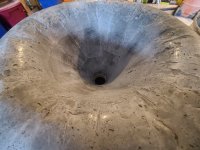 20200729_195619.jpg458.3 KB · Views: 137
20200729_195619.jpg458.3 KB · Views: 137 -
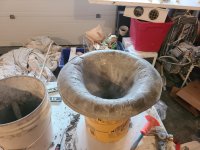 20200729_195346.jpg560.1 KB · Views: 121
20200729_195346.jpg560.1 KB · Views: 121 -
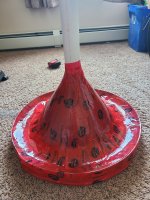 20200725_190139.jpg649.8 KB · Views: 116
20200725_190139.jpg649.8 KB · Views: 116 -
 20200125_170055.jpg211 KB · Views: 113
20200125_170055.jpg211 KB · Views: 113 -
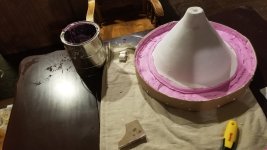 20200119_210546.jpg337.6 KB · Views: 123
20200119_210546.jpg337.6 KB · Views: 123 -
 20200114_183535.jpg186.1 KB · Views: 127
20200114_183535.jpg186.1 KB · Views: 127 -
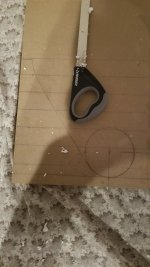 20200114_182844.jpg257.3 KB · Views: 113
20200114_182844.jpg257.3 KB · Views: 113 -
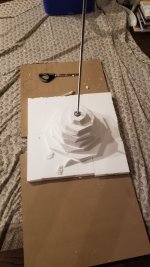 20200114_182839.jpg293.5 KB · Views: 120
20200114_182839.jpg293.5 KB · Views: 120 -
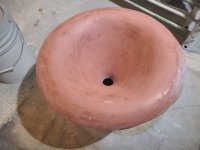 20200802_205430.jpg314.9 KB · Views: 123
20200802_205430.jpg314.9 KB · Views: 123 -
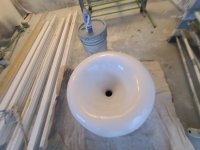 20200802_205535.jpg283.5 KB · Views: 120
20200802_205535.jpg283.5 KB · Views: 120 -
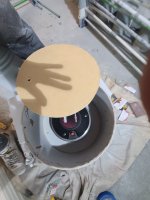 20200803_144620.jpg301.1 KB · Views: 125
20200803_144620.jpg301.1 KB · Views: 125 -
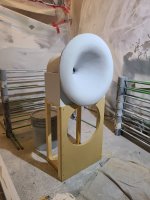 20200803_161333.jpg455.4 KB · Views: 131
20200803_161333.jpg455.4 KB · Views: 131 -
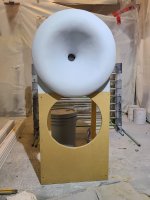 20200803_163158.jpg412.7 KB · Views: 130
20200803_163158.jpg412.7 KB · Views: 130
@chebum Those graphs would make more sense to me if I could see the fundamental.
No problem. Same charts, different presentation.
Oktava mic reported lower harmonic distortion, but this mic isn't a calibrated one...
Both charts are with "var smoothing" in REW. 500ms window. In-room measurements.
Awesome project...thx for the photos.Heres a few more pics of the construction process, found a pic of the scree I used and the angles from an excel sheet I downlaoded called OSWG somewhere online. It was a silly amount of work which is why I never built another one!
And yeah, I've occasionally built a prototype speaker that worked really great, but was simply too much work to do again.....sigh
"The cutoff frequency of a horn is determined by the physical dimensions of the horn, such as its length, mouth area, and expansion rate. It is the frequency at which the horn's output drops by 3 decibels (or half power) compared to its output at lower frequencies. "
f3... Why didn't I think of that 🤔 this is why cutoff needs to be specified, as to what a person is meaning.
f3... Why didn't I think of that 🤔 this is why cutoff needs to be specified, as to what a person is meaning.
Last edited:
...at higher frequenciescompared to its output at lower frequencies
I think if you are going to use the term F3 for cutoff, this will skew the results in a way undesirably, for certain horns.... My horn is down 3db from peak spl at 500hz. If I judge f3 by going off the trend of the line, looking to where the trend breaks character and falls rapidly, my f3 is 162hz. This is basically judging by the other lower frequencies above 163hz and the trend it creates as a FR. Outside of the modulation due to being truncated, the trend is consistent till about 172hz starting to descend at about 2khz.
My horn buider obviously chose "Cutoff" to mean f6 which is 150hz..... Fool me once, shame on you...
My horn buider obviously chose "Cutoff" to mean f6 which is 150hz..... Fool me once, shame on you...
What I wish to understand is how and when a horn expands. In a literal sense there is only one tractrix curve right?
What I think is happening in a tractrix horn is that there is a throat section....The flare rate of the throat section decides the wall angle starting at the exit... then at when ever we decide the throat section is done, the tractrix expansion begins.... the end. I don't think that is right, but it seems like it might be close.
I do recall something about a tractrix horn starting with the mouth, and the working backwards?? The end of the curve should be a certain angle at the end, before roll off??? But when you through in the flare rate, it throws me off... Maybe flare rate potentially truncates the tractrix portion of the wall.... leaving only a certain flare rate to be a true or full tractrix expansion?? That doesn't seem right either....
It just seems that a tractrix curve only expands at a certain rate... so how do we get all the variation between the initial flare rate and when the actual tractrix curve starts and finishes???
Last edited:
- Home
- Loudspeakers
- Multi-Way
- Is it possible to cover the whole spectrum, high SPL, low distortion with a 2-way?